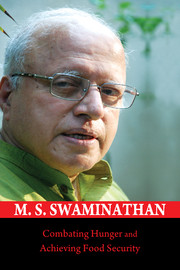Book contents
- Frontmatter
- Contents
- Foreword
- Preface
- Acknowledgements
- Abbreviations
- 1 Genesis and Growth of the Yield Revolution in Wheat
- 2 Our Agricultural Heritage
- 3 Shaping Our Agricultural Destiny
- 4 Thrust on Farm Revival
- 5 Nutri-farm Movement
- 6 Nutrition-sensitive Agriculture
- 7 Food Losses and Food Waste
- 8 Rice in Zero Hunger Challenge
- 9 Monsoon Management
- 10 Importance of Ecological Conservation
- 11 Caring for Ecology and Heritage
- 12 Conserving Biodiversity
- 13 Overcoming Hidden Hunger through Aquaculture
- 14 Biofuels – The Way to Go
- 15 Food Security
- 16 Vigilance for Sustainable Food Security
- 17 Food Security and Social Protection
- 18 Food Security and its Role
- 19 Sustaining the Livestock Revolution
- 20 Challenges in the Year of Science
- 21 Agriculture and Humanism
- 22 Fostering the Science of Science Communication
- 23 Olympic Move for Saving Children
- 24 Youth: The Agents of Change
- 25 Role of Women in Agricultural Production
- 26 Know-how to Do-how
- 27 From Bengal Famine to Right to Food
- 28 Financial Institutions and Fighting Food Inflation
- 29 Public Good Research in Agriculture
- 30 The Future of Indian Agriculture
- Bibliography
19 - Sustaining the Livestock Revolution
Published online by Cambridge University Press: 18 December 2015
- Frontmatter
- Contents
- Foreword
- Preface
- Acknowledgements
- Abbreviations
- 1 Genesis and Growth of the Yield Revolution in Wheat
- 2 Our Agricultural Heritage
- 3 Shaping Our Agricultural Destiny
- 4 Thrust on Farm Revival
- 5 Nutri-farm Movement
- 6 Nutrition-sensitive Agriculture
- 7 Food Losses and Food Waste
- 8 Rice in Zero Hunger Challenge
- 9 Monsoon Management
- 10 Importance of Ecological Conservation
- 11 Caring for Ecology and Heritage
- 12 Conserving Biodiversity
- 13 Overcoming Hidden Hunger through Aquaculture
- 14 Biofuels – The Way to Go
- 15 Food Security
- 16 Vigilance for Sustainable Food Security
- 17 Food Security and Social Protection
- 18 Food Security and its Role
- 19 Sustaining the Livestock Revolution
- 20 Challenges in the Year of Science
- 21 Agriculture and Humanism
- 22 Fostering the Science of Science Communication
- 23 Olympic Move for Saving Children
- 24 Youth: The Agents of Change
- 25 Role of Women in Agricultural Production
- 26 Know-how to Do-how
- 27 From Bengal Famine to Right to Food
- 28 Financial Institutions and Fighting Food Inflation
- 29 Public Good Research in Agriculture
- 30 The Future of Indian Agriculture
- Bibliography
Summary
Dairy farming
The livestock sector plays a vital role in the rural economy of India. Also, the ownership of livestock is more egalitarian. Unlike land, the poor own nearly 80 per cent of the livestock. Therefore, livestock and livelihoods have an intimate relationship, particularly in arid and semi-arid areas. The most important sector is dairy, which alone contributes approximately 100,000 crore to GDP. Relative to this huge contribution, investment in the dairy sector has been extremely low. The dairy industry provides employment to 18 million people (9.8 million in primary and 8.6 million in subsidiary employment), not including people employed in sale, reprocessing and transport of animal products at secondary market level. Of these, 70 per cent are women and 67 per cent have no access to land, credit or technology. Of the 70 per cent of rural households that own livestock, the vast majority are either landless or marginal farmers. Therefore, economic development of the dairy industry can be a powerful lever for increasing rural income and employment as well as eradication of poverty.
The dairy sector is also vital for abolishing malnutrition and achieving food security. In a country where 42 per cent of the population consumes only a lacto-vegetarian diet and majority of the rest of the population consumes comparatively low levels of animal protein, milk products constitute a major source of the protein required for a balanced diet. Per capita milk consumption in India has risen dramatically over the past three decades but still remains 25 per cent below the world average. This figure appears even less adequate in view of the low levels of consumption of non-dairy protein. The growth of the dairy industry has largely been achieved by the organization of producers, processing and marketing cooperatives, the promotion of crossbred stock and delivery of veterinary services. Yet, only 35 per cent of milk production is in the organized sector, which means that most dairy farmers lack access to these critical services. At the same time, 70 per cent of India's milk production is generated by only seven states, indicating that there is still substantial scope for extending the White Revolution to low production regions.
While India's total milk production is the highest in the world, productivity per animal is extremely low by international standards.
- Type
- Chapter
- Information
- Combating Hunger and Achieving Food Security , pp. 99 - 104Publisher: Cambridge University PressPrint publication year: 2016



